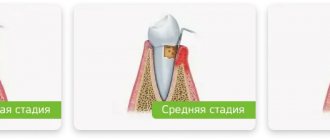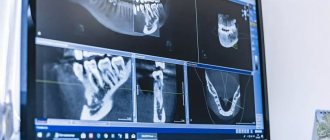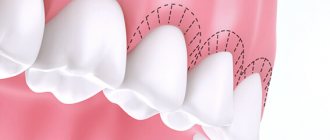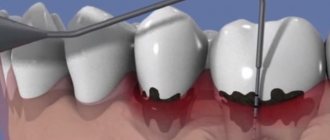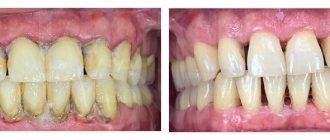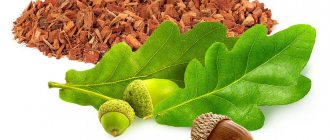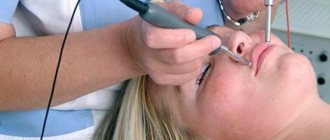Curettage in dentistry is a procedure for cleaning a cavity (for example, a periodontal pocket) from foreign matter, such as dental plaque, pieces of dead gum tissue, etc. Curettage is one of the important methods of treating periodontitis, but this method is also used in other cases. For example, after tooth extraction, curettage of the hole can be performed, which allows you to remove from the wound all the remains of the extracted tooth - fragments of roots, particles of filling material, etc. In essence, curettage is a surgical procedure, but in most cases, with the development of periodontitis and the formation of gum pockets, this is the only method that allows you to remove from the roots of the tooth everything that provokes the proliferation of microbes that destroy the attachment of the tooth to the bone - and stop the development of the disease.
How to do curettage
Curettage is a surgical operation. Plaque, stone, and pathological tissue are removed from the periodontal pocket. If necessary, osteoplastic surgery is performed. This is necessary if bone resorption has already begun.
Curettage must be carried out in the treatment of periodontitis and periodontal disease, as this is one of the most effective methods for eliminating inflammation in the gums. According to the technology of the procedure, there are two types of it:
- Open;
- Closed.
Closed curettage
Can be used if the depth of the periodontal pocket does not exceed 5 mm, and pathological changes in the bones have not yet begun. When performing closed curettage, pathological tissues are exposed to ultrasound and hand instruments in the form of hooks, with the help of which granules are removed from under the gums. There is no cutting of the gums, so the procedure can be considered more gentle.
Flaws:
- The doctor performs the operation almost blindly; he does not see the subgingival space. Therefore, it is not possible to thoroughly clean the periodontal pocket in all cases.
- There is a risk of incomplete cleaning. Success largely depends on the experience of the dentist performing the procedure.
Due to its characteristics, closed curettage is suitable for mild to moderate periodontitis and periodontal disease. Sometimes it becomes the only possible method, since others cannot be used for some reason.
What tools are used
Doctors usually use special hand instruments. In modern dental clinics, treatment of the subgingival area and root polishing is carried out with the additional use of ultrasound or laser. The use of such technologies allows us to achieve better and more durable results, as well as reduce the risks of complications.
As for hand tools, today specialists have a fairly wide range of different designs at their disposal, most of which, however, have a similar structure: handle, working area and shoulder. Tools can be made of metal, plastic or Teflon, or have diamond coating. Each modification is designed for use in a specific clinical case, and the choice here largely depends on the stage of the pathology and the age of the patient.
Dentists have many different instruments in their arsenal for the procedure.
Tools made of Teflon and plastic are suitable for removing soft plaque from children and adults. But to clean the implant under the crown, special plastic products are used - implacers. The diamond-coated option is relevant for cases where gum excision is required - this instrument has a semicircular working area and a slightly curved arm.
Open curettage
Used if the depth of periodontal pockets is more than 5 mm. This is a surgical intervention, but compared to a closed one, the effectiveness is much higher. Since open curettage requires cutting into the gums, the operation is performed under anesthesia.
Stages:
- The doctor cuts the gum and peels it away from the tooth. After exfoliation, the tooth root is completely exposed. The dentist gets full access to the bone tissue.
- Cleaning and antiseptic treatment. The roots are cleaned of accumulated plaque and stone and polished using a burr and special pastes. After this, the tissues are treated with an antiseptic.
- Osteoplasty. This stage is not always necessary. With advanced periodontal disease, bone resorption gradually begins around the teeth, which will lead to loosening and tooth loss. In order to restore the bone, osteoplastic material is implanted.
- Suturing. After plaque removal, the gingival flap is returned to its place and sutured. A bandage with an antiseptic solution is applied on top.
Open curettage is a more complex procedure, but more effective than closed curettage. The surgeon sees the entire subgingival space and has access to bone tissue. Therefore, the quality is very high; both plaque and granulation tissue are completely removed from under the gums.
If necessary, open curettage can be performed simultaneously with flap surgery. It is indicated if the gum tissue is loose and the gum contour is disturbed. Very often, with periodontal disease, the gums begin to overhang the teeth. This violates the aesthetics of a smile. During flap surgery, the dentist removes excess mucous membrane and then sutures the gum.
Laser therapy method for teeth cleaning
The laser therapy technique is the most modern today. Its effect is based on the evaporation of liquid. The fact is that there is much more of it in plaque and tartar than in enamel. The laser, evaporating liquid from deposits, allows you to destroy the stones layer by layer.
Hygienic cleaning of teeth with a laser is carried out at a distance, without contact of instruments with oral tissues. Thus, this technique is completely painless. When it is carried out, there is no chance of infection, and the laser itself has an antiseptic effect.
Another advantage of laser cleaning at the dentist is that it helps to further whiten the enamel. Thanks to this, there is no need for another procedure. In addition, the light flux has a bactericidal effect and effectively fights pathogenic microorganisms, helps in the regeneration of wounds and prevents the development of caries. The entire procedure does not require any special preparations and is painless for the patient.
Laser teeth cleaning is contraindicated under the following conditions:
- Rhinitis and ARVI;
- The presence of implants, including pacemakers, in the patient’s body;
- Severe infectious diseases (HIV infection, tuberculosis, hepatitis);
- The presence of orthopedic structures in the oral cavity;
- The patient has a history of epilepsy and asthmatic attacks.
Rehabilitation
Curettage of periodontal pockets is a surgical operation, after which there will be a period of rehabilitation. Following the recommendations will speed up gum healing, make it less uncomfortable, and avoid complications.
Oral care rules depend on the method:
- Closed curettage. Immediately after surgery, you should not eat for several hours. On the first day, it is better to refrain from brushing your teeth with a brush and toothpaste, replacing it with rinsing. During the entire rehabilitation period, you need to monitor your diet - exclude solid foods and foods containing dyes. After curettage, there may be increased sensitivity of the teeth and gums. A special paste that your doctor will recommend will help you remove it. It is imperative to rinse your mouth with solutions of strengthening and anti-inflammatory medications.
- Open curettage. Since this surgery requires cutting into the gum, recovery takes longer. Recommendations for the first 1-2 days after surgery are the same as for closed curettage. It is very important to minimize the possible stress on the gums and teeth. It is advisable to reduce physical activity at first. Until the stitches heal, your mouth should be rinsed with solutions of antibacterial and anti-inflammatory agents. This will help speed up healing and tissue regeneration.
Pros and cons of the technique
The procedure is effective, it allows you to qualitatively clean fairly deep periodontal pockets and eliminate pathological foci. Ultrasound treatment using the Vector device cannot be compared in effectiveness with open curette, and if the latter fails, the only solution to the problem will be patch surgery - for pockets with a depth of more than 10 mm. In addition, this technique allows you to simultaneously build up atrophied areas of bone tissue, completely restore the functionality of the affected area, and at the same time clean the root zone.
The advantages of closed curette include its affordable cost, but this procedure is not very effective for pockets deeper than 5 mm. The technique is not used for moderate and severe stages of periodontal disease, since in 99.98% of cases the pathology recurs1. The disadvantage of the open method is its high cost, the duration of the procedure, which can take several hours to treat 6-7 teeth, as well as high demands on the professionalism of the periodontist surgeon. Violation of the technique for performing the necessary manipulations can lead to damage to the internal structures of the tooth and severe injury to the soft tissues.
The photo shows teeth before and after the procedure
Flaws
Gum curettage is a simple dental operation with good results. However, it is not without its drawbacks:
- Traumaticity. Like any surgical intervention, curettage injures soft tissue.
- The need for anesthesia. Normally, the operation is performed under local anesthesia. Sedation or general anesthesia is used in extreme cases or when the patient is in panic.
- Rehabilitation. The gums heal quickly, but at this time it is necessary to follow the recommendations and take care of the oral cavity. Infection of the wound can lead to complications.
Alternatives to curettage
Alternative technologies are suitable as prevention or in the early stages of pathology development. At the Zuub clinic they use:
- Comprehensive teeth cleaning. This is good prevention. It can be used as one of the stages of complex therapy, but not as an independent treatment. During cleaning, using ultrasound and a mixture of water, air and soda, tartar and plaque are removed from the surface of the teeth. You won't be able to empty your pockets this way.
- Treatment with the “Vector” device. A method for cleaning and disinfecting shallow periodontal pockets. In mild stages of periodontal disease, it can be used as an alternative to closed gum curettage, but it cannot replace open vector therapy. "Vector" is more effective than classic complex cleaning. It is based on a combination of exposure to an ultrasonic wave and a special suspension with abrasive particles. Since the ultrasonic wave is applied vertically, it penetrates deeply under the gum. In addition, ultrasound has a good disinfecting effect. Thanks to this, with a small depth of periodontal pockets and an undeveloped pathological process, it can give a good result.
The periodontist selects the gum treatment technology based on the clinical picture.
Come for a consultation with a dentist at the Zuub clinic.
What are the indications for professional teeth cleaning at the dentist?
It is recommended to consult a dentist for such a procedure in the following cases:
- The need to eliminate tartar in both supragingival and subgingival locations;
- Removing hard and soft plaque;
- For the prevention of diseases of hard dental tissues (caries and non-carious lesions);
- Treatment and prevention of periodontal diseases (gingivitis, periodontitis, periodontal disease);
- Elimination of bad breath;
- Prevention of the development of periodontal bleeding;
- As the first stage of the teeth enamel whitening procedure.
The frequency of the procedure is recommended once every 6 months, but more often is possible. Modern methods of professional teeth cleaning are very gentle and do not have a negative effect on the oral cavity or to a minimal extent.
You can independently determine when you need to visit a clinic for professional cleaning by looking at the following negative signs in the oral cavity:
- Bad breath, but gastrointestinal diseases have not been diagnosed;
- There is bleeding gums, itching and burning in the mouth;
- Visual presence of tartar;
- The tooth may hurt;
- Change in periodontal color (cyanosis or hyperemia);
- There is subsidence of the gums, they may bleed;
- There is a feeling of heaviness and pain in the periodontium when chewing food, especially sour or spicy;
- There is a violation of the periodontal attachment.
It should be noted that there are practically no contraindications for professional teeth cleaning. There are only general relative limitations, such as the acute stage of inflammatory processes in the body.
The basic methods of professional teeth cleaning are based on a modern correct approach to the problem and involve a complex effect during the process of professional teeth cleaning at the dentist. At the same time, manual and hardware cleaning methods are distinguished.
Hardware methods of teeth cleaning
Professional oral cleaning is performed by periodontists or hygienists. The procedure is preventive and does not require special preparation; in extreme cases, local anesthesia is performed. Of the hardware methods, the following techniques are the most popular.
Cleaning teeth at the dentist using the air flow method
During the cleaning process using the Air Flow method, hard dental deposits are exposed to abrasive material and a powerful stream of directed air. The abrasive commonly used is sodium bicarbonate. Cleaning takes place simultaneously with the supply of a thin stream of water. For an additional refreshing effect, different flavors (mint, lemon or menthol) are added to the water.
Cleaning occurs due to soda particles, which hit the enamel at high speed, removing both soft and hard plaque. At the same time, the supplied stream of water washes away the removed deposits and stones so that they do not interfere with further exposure. Water also helps reduce the heating of tooth enamel that occurs during this manipulation.
The Air Flow technique helps not only to eliminate plaque, stones and pigmentation, but also to thoroughly polish the enamel, at the same time ensuring its partial lightening. However, it should be remembered that air flow cannot whiten tooth enamel by several tones. After manipulation, hard tissues will only acquire their original color.
Reviews about Air Flow are in most cases positive, since the main advantages of the technique include:
- Availability;
- Safety;
- Painless;
- High efficiency.
The entire effect takes no more than 30 minutes. Moreover, the air flow is selected individually for each patient. And the power directly depends on the volume of dental plaque that needs to be removed. In addition, the thickness of the enamel and the individual sensitivity of the teeth are taken into account.
Despite the positive aspects of professional teeth cleaning using the Air Flow method, there are quite significant contraindications to this method. First of all, these are diseases of the respiratory tract. These include:
- Obstructive bronchitis;
- Bronchial asthma;
- Allergy to airflow components;
- Acute periodontal and hard tissue diseases;
- Multiple caries;
- Thin layer of enamel;
- Non-carious lesions associated with increased sensitivity of enamel and its excessive fragility.
The cost of the procedure in dental offices is usually not high and is affordable for everyone. In just 3-4 thousand rubles you can get a good preventive effect using the Air Flow method, as well as additional services to strengthen the hard tissues of teeth. The effect after the procedure lasts depending on the patient’s lifestyle and the absence or presence of somatic diseases. In any case, it is advisable to visit the dentist again no later than six months later.

